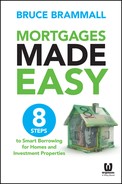Assumptions and disclaimers
This book has not relied upon any individual's circumstances.
Bruce Brammall is a licensed financial adviser and mortgage broker with Bruce Brammall Financial and Bruce Brammall Lending respectively. However nothing in this book should be taken as individual financial advice and readers should always seek specific financial advice relevant to their own situation before making any decisions or entering into any transactions.
Tax and accounting
The author does not represent himself to be a tax accountant and information in this book should not be relied upon for taxation advice for your individual circumstances.
Information in this book, including tax rates, tax law and stamp duty, are subject to change by governments without notice. You should consult with your accountant to understand how individual strategies would impact on your personal taxation circumstances.
Assumptions
For the most part in this book, where examples have been used, we have used property price growth (or appreciation) of 5 per cent and rental yields of 4 per cent. This gives a total return from property of 9 per cent. In its paper titled ‘Is Housing Overvalued?' in July 2014, the Reserve Bank found that rents had maintained a relatively constant rate of 4.2 per cent over the last 60 years. While yields are usually fairly stable, property prices can fluctuate considerably.
We have generally used interest rates that are higher than at the time of writing, when the Reserve Bank of Australia had an official interest rate of 2.5 per cent and the standard variable rates of the major banks were about 5.9 per cent.
The marginal tax rates used in this book are generally going to be those for the 2014–15 financial year. Those marginal tax rates will generally include 2 per cent for the Medicare levy (including the 0.5 per cent for the National Disability Insurance Scheme) and the 2 per cent deficit levy for those earning more than $180 000.
In regards to superannuation, the assumptions used relate to the 2014–15 financial year, including for tax and conditions of release. Governments have speculated that the age at which Australians might be able to access their superannuation could rise in future years.
Regarding chapter 6, on self-managed super funds and gearing property investing: The information on SMSFs and gearing was current at the time of writing. Governments have a habit of fiddling with superannuation rules and it's recommended that readers check current laws before taking action to invest in this space.
